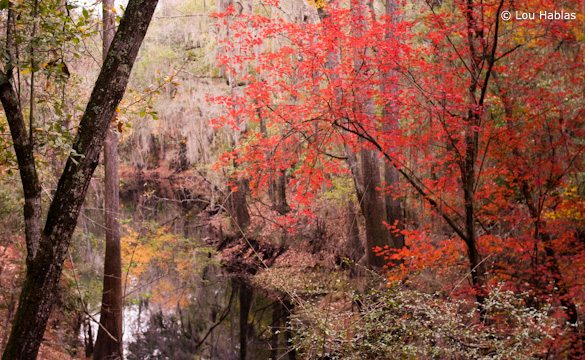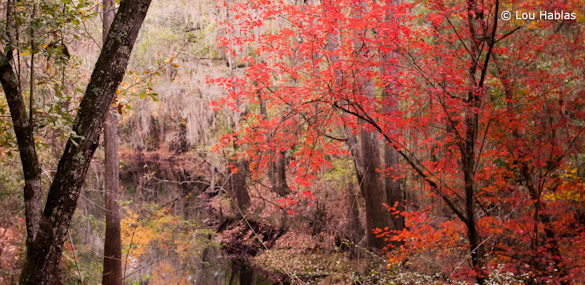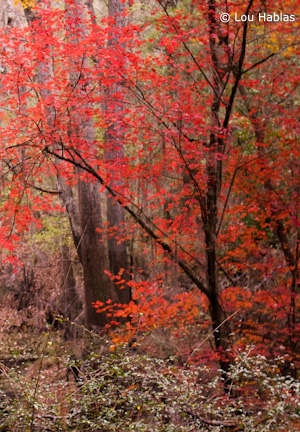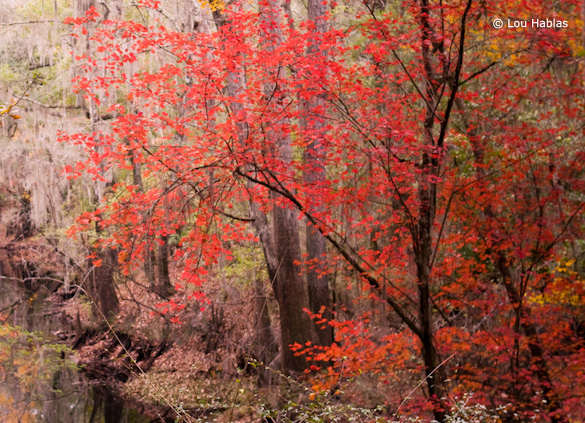This week’s photograph, by Lou Hablas, is from O’Leno State Park in Florida. Did you know they had fall color like that in Florida? I sure didn’t.
Lou said that he made this photograph on an overcast and sometimes rainy day while on a hike with his family. That weather provided perfect conditions for this subject. I mentioned last week how soft light enhances colors and color contrasts, but it has another benefit: simplification. Forests have random, chaotic configurations of branches, trunks, and leaves. Sunlight filtering through the trees creates splotchy patterns of light and dark, further adding to the visual confusion. Soft, even light helps simplify such scenes.
But forests are still difficult to photograph, even on an overcast day, because it’s hard to create visual order out of so much chaos. I think Joe did a pretty good job of finding a coherent design; we grasp the main ideas easily, and it doesn’t seem too confusing. The main focal point is the red maple on the right side, and its Y shape echoes the lines of the trunks on the left edge of the frame, giving this image structure and repetition.
While soft light can help simplify forest scenes, it’s essential to keep the sky out of the frame. The overall design of Lou’s photograph works pretty well, but the bright patch of sky at the top of the picture and its reflection below both pull attention away from more interesting objects, like the red tree. To make matters worse, the sky is right along the edge, causing the viewer’s attention to bleed out of the frame. One solution would be to crop both the top and bottom of the picture. This creates a semi-panoramic shape, which is fine, but the unintended side effect is that it emphasizes the trees on the left; they seem too prominent, and draw attention away from the red maple.
So what’s the solution? Before reading on, look at the original photo at the top of the page. What catches your eye the most?
Most people will probably say the red tree; that was certainly my answer. And I know that’s what originally attracted Lou to the scene, as he told me as much in an email. He also told me that he then noticed other elements, like the lake, moss, other trees, leaves on the ground, etc., and tried to include those in the composition.
This is a common dilemma when composing landscape photographs. Something grabs your attention, then you notice other interesting things around it, and you want to include those too. The question becomes, do those other things add to the photo, or distract from your original idea?
And the answer is… it depends. Every situation is different. If the other elements create an interesting juxtaposition with the original subject, and you can include them without adding unwanted clutter, then those additions might improve the image. But typically it doesn’t work that way—more complexity usually means more confusion and distraction.
That red maple is a very strong subject. It has great color, plus good lines and structure. It’s interesting enough by itself to make a good photograph—it doesn’t need anything else. So here are two other crops that fill most of the frame with just that tree. I’m sure there were many other possibilities, but these work.
The moral of this story is: When in doubt, stick with your original idea, the thing that caught your eye and motivated you to take the picture in the first place.
Technically, this image looks properly exposed, and the white balance, contrast, and saturation seem about right. A larger view shows that the background is out of focus. Lou mentioned that this photograph was made a couple of years ago, and there are things he would do differently now, like stopping down the aperture to get more depth of field—a good idea.
Thank you Lou for sharing your image! You can see more of his work on Flickr.
I’ll be taking next week off to celebrate my wife’s birthday, but I’ll be back with another critique on March 16th or 17th.
If you’d like your images considered for future critiques, just upload them to the Flickr group I created for this purpose. If you’re not a Flickr member yet, joining is free and easy. You’ll have to read and accept the rules for the group before adding images, and please, no more than five photos per person per week. Thanks for participating!













Jason, thanks for offering your perspective on the different crops. As I said, personally I’m not crazy about the panoramic crop — there’s something about it that makes those trees on the left grab too much attention. Of these versions, I like the last one, the horizontal with the red tree filling most of the frame, the best. It puts the attention on the maple, but shows just a bit of the interesting moss on the left side of the frame. It’s true that the vertical loses this, and maybe it’s too tight, but it does create a nice juxtaposition with the triple-trunked tree just behind and to the left of the maple.
Anyway, that’s my take, but this is all subjective, and reasonable people can disagree!
Hi Michael,
I’m really enjoying these critiques of yours. You’re addressing so many of the issues I face in my attempt to improve my photography! Thank you!!
One thing that you have done here, but not really called out, is how it is OK to crop your image. I hear all the time people saying that it’s “impure” to crop. As you show here, balderdash!
So thanks for showing and doing just that to make this image work better. It’s such a useful tool and, if you’ve used a tripod and stopped down, the image will be just as crisp as you could want.
Again, I’m just eating up these critiques! Thanks so much for doing them.
Bob
Another “Wow” from me, Michael! As Bob noted above, your critiques really are enjoyable and insightful; thank you for your thoughts and insights on my image. Your constructive criticism is always fantastic and I *REALLY* love how you concluded this week’s post. The additional crops you suggested never crossed my mind, but I love them. Thank you and, again, I echo Bob’s sentiment: “I’m just eating up these critiques! Thanks so much for doing them.”
Opening Lightroom right now to play a bit and look forward to your next edition…
Lou (aka Joe;)
Bob, Lou, thanks for your comments. I’m glad you’re both enjoying the critiques! And Lou, thanks again for letting me throw (hopefully soft, foam-rubber) slings and arrows at your photograph.
Bob, about the cropping, I’m not a purist in this regard, but there are some technical reasons why it’s not a good idea to make major crops after the fact — mainly because you’re throwing away resolution. If you crop half the photograph from a 12 megapixel camera you’re down to 6 megapixels. The actual result is worse, as lens resolution becomes a factor. So while I might crop an image in a critique like this to illustrate an alternate composition, it’s better to compose it that way in the field.
Having said that, I think minor cropping or trimming is fine — I do it all the time. Sometimes the subject doesn’t fit the aspect ratio of your sensor, so you might want something more panoramic or square. If I’m in doubt about whether to leave an object near the edge of the frame in or out I’ll leave it in, because I know I can easily crop it out later, but I can’t add something that isn’t there.
Hi Michael, yet another great critique, and thanks to Lou for sharing his image. I just wanted to chime in and mention that of all the crops in the critique I much prefer the panoramic (no sky, bright reflection) over the others. It’s amazing to me how much of a difference this subtle crop made. IMO it turned the good picture into a great pic that I can imagine hanging on a wall somewhere.
On the flip side, the vertical crop of the red maple to me loses everything cool about the original. Not sure what others think but that diagonal tree on the left actually lends itself very well to the whole image (maybe it’s the fact that it is counter diagonal to the “Y” in the red maple) and removing that seems to decrease the interest in the pic (again, IMO). Also the immense detail on the left and background is also lost with the vertical crop.
I could go on and on, but I’ve said too much already (as is always the case). Again congrats on a good critique and thanks Lou for sharing you lovely picture.
Thanks for the awesome critiques, Michael. I get to learn so much! Thanks Lou for the photo!
I have cpl of questions – nothing regarding cropping though. I hope its ok..
1- What kind of white balance works here?
2- If I used Zone system (you know I loved learning the Zone System!), and framed a shot like the last crop, what zone does the scene needs to be in? Since there are no blinkies, how do you expose for this shot?
I know this is no way related to what is being discussed here but these were the 2 questions that came into my mind as soon as I saw this image… Hope its ok..
Those are good questions Vidya, regardless of whether previously discussed, so I’m happy to answer them:
1- I suppose cloudy white balance would be the first try, since this was a cloudy day. But I usually just leave my camera on automatic white balance and adjust later. This is easy to do with Raw images. Any program that works with Raw files, like Lightroom, Adobe Camera Raw, Nikon Capture, Aperture, etc., has a color temperature slider that allows easy adjustment. With a calibrated monitor I simply adjust to taste. As I said, I think the white balance looks good in this image.
2- First I always look at the brightest important highlight. In the last crop it’s the whitish moss upper-left corner. I’d probably call this Zone 6 1/2 or 7, so spot metering that moss (making sure the whole spot is filled with just that whitish tone), I’d overexpose 1 1/2 to 2 stops from whatever the meter said. For more on this topic see my article on the Zone System in the March issue of Outdoor Photographer:
http://www.outdoorphotographer.com/how-to/shooting/the-digital-zone-system.html
Could not figure out where else to leave this comment so here goes.
I just finished you current book “Digital Landscape Photography.”
What a great read, I really spent some time going over each word and photo and learned so much. Thoroughly enjoyed it front to back cover. Cannot wait for your next book.
I am also enjoying this new blog and photoo critiques, keep up the good work.
Thanks very much Patsy! I’m very glad you like the book and blog, and hope you’ll continue to learn useful things here.
Thanks Michael, that helped a lot !!
Thanks for another great critique and thanks Lue for providing an image.
I looked through the comments to see if anybody addressed it, and it looks I am not the only one.
I agree with Jason. I really liked the original image, with the dark tree on the left. I liked the panoramic crop, and did not see the need to cut out that tree. I found it well balanced with lighter, red tree on the right, forming a pleasing scene. I like your final crop, but seeing the original, that is what I would go with.